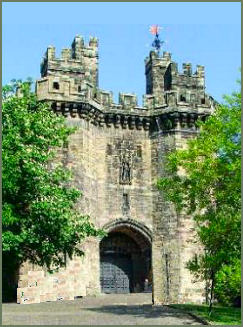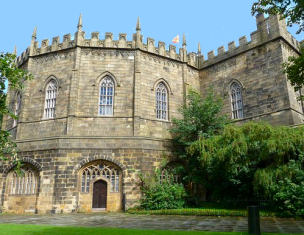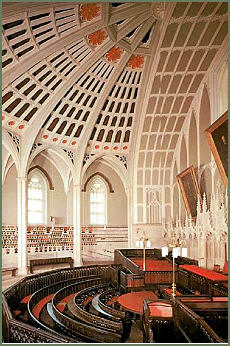Lancaster Castle
OS Grid ref:- SD473619
 Lancaster Castle may have been founded in the eleventh century on the site of a Roman fort overlooking a crossing of the River Lune.
Lancaster Castle may have been founded in the eleventh century on the site of a Roman fort overlooking a crossing of the River Lune.
 The castle which we see today dates in part to the middle of the twelfth century, when the great Keep, otherwise known as the Lungess Tower, was built on the site of an earlier tenth century Motte and Bailey castle.The castle was gradually enlarged thrroughout the Middle Ages, reflecting its importance as a defensive structure and a centre for the administration of justice.
The castle which we see today dates in part to the middle of the twelfth century, when the great Keep, otherwise known as the Lungess Tower, was built on the site of an earlier tenth century Motte and Bailey castle.The castle was gradually enlarged thrroughout the Middle Ages, reflecting its importance as a defensive structure and a centre for the administration of justice.
The Plantagenet King Henry III spent large ammounts of money on LancasterCastle, £200 in 1243 and £250 in 1254 for work on the gatehouse and creating a stone curtain wall. When Henry Duke of Lancaster ascended the throne as King Henry IV in 1399, he began adding the present gatehouse and made alterations to the top storey of the keep. The keep measures (66 feet (20 metres) high and has four storeys; each floor divided into two rooms. The castle was damaged during Scottish invasions of England in 1322 and 1389.
During the Civil War, a small Parliamentarian force captured the castle in February 1643 and established a garrison there. The outer defences fell to the Royalists in March, and they conducted a two day siege of the castle. The Royalists attempted to recapture Lancaster in April and again in June but the town and castle remained under Parliament's control until the end of the war. In August 1648 Lancaster withstood a siege from a Royalist force under the command of the Duke of Hamilton. After the war, Parliament ordered that the castle should be slighted, with the exception of buildings necessary for administration and use as a county gaol.
The Castle was also one of Europe’s longest serving prisons until March 2011. Amongst the most famous prisoners were the Pendle Witches, who were imprisoned, tried, convicted and sentenced to death at the castle in 1612.
 The story of the Pendle witches revolves around two large, destitute families, the Chattoxes and the Demdikes, who held a local reputation for practicing for black magic. They dealt in spells and curses, providing a service for their neighbours but intimidating their enemies with threats of misfortune and death.
The story of the Pendle witches revolves around two large, destitute families, the Chattoxes and the Demdikes, who held a local reputation for practicing for black magic. They dealt in spells and curses, providing a service for their neighbours but intimidating their enemies with threats of misfortune and death.
At their trial, all but one was found guilty of various crimes of witchcraft, including murder and a plot to blow up Lancaster Castle. Nine of the accused – Alizon Device, Elizabeth Device, James Device, Anne Whittle, Anne Redferne, Alice Nutter, Katherine Hewitt, John Bulcock and Jane Bulcock – were found guilty during the two-day trial and hanged at Gallows Hill in Lancaster on 20 August 1612; Elizabeth Southerns died while awaiting trial. Only one of the accused, Alice Grey, was found not guilty.
George Fox, the founder of the Quaker movement, was amongst a number of Quakers who were imprisoned in the Castle, as they were considered politically dangerous.
The main entrance to the castle is through the fifteenth century gatehouse, described by John Champness as 'perhaps the finest of its date and type in England.' Legend attributes the building of the gatehouse to John of Gaunt, Duke of Lancaster, although it was actually built by his son King Henry IV, the first Lancastrian king. Two semi-octagonal towers flank a passageway protected by a portcullis. The niche above the gate, contains a statue of John of Gaunt, which was placed there in the ninteenth century.
The late eighteenth- early nineteenth century Shire Hall (pictured above right) next to the keep is a large ten-side room and contains a magnificent display of heraldic shields. A cylindrical tower the south-west corner of the castle, is named Adrian's Tower, as according to legend, it was built by the Roman Emperor Hadrian. The tower was, however, built in the early thirteenth century, probably during the reign of King John. The Grand Jury Room includes some superb Gillow furniture, whilst in the Crown Court the branding iron is still on display.
